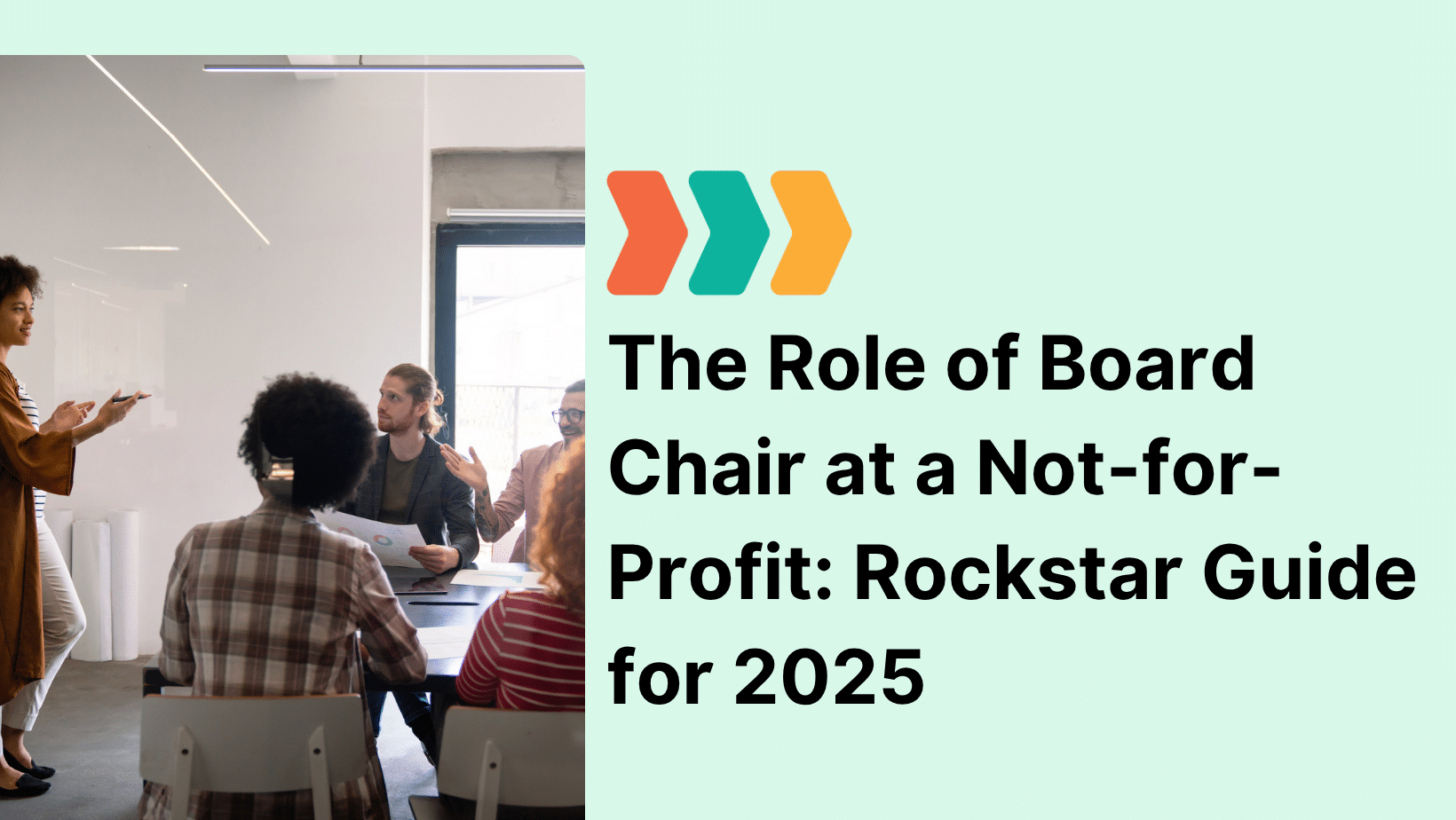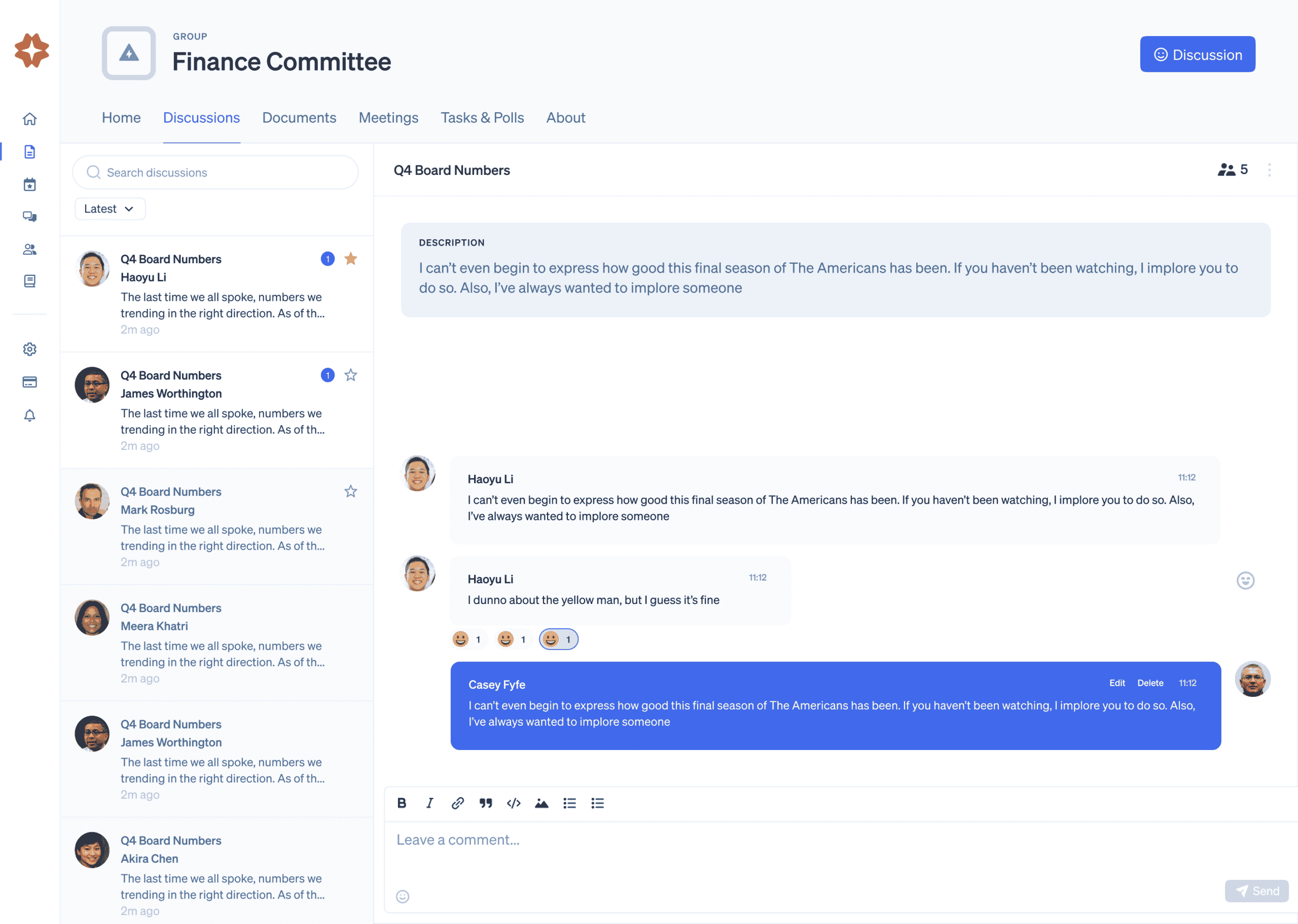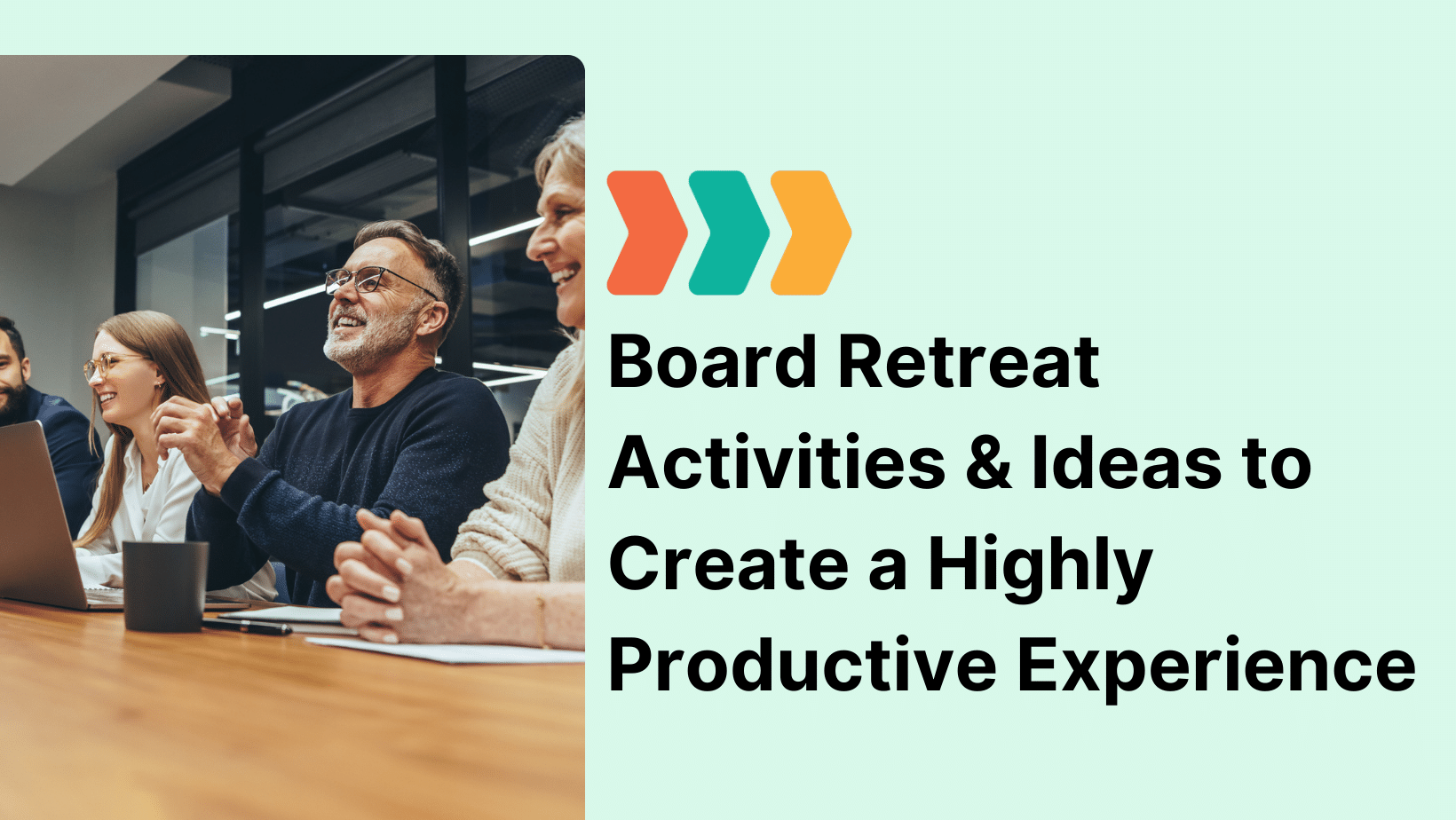Modern governance moves quickly, and the role of a board chair at a not-for-profit is more dynamic than ever. This guide breaks down what the job really entails in 2025—plus practical tips, fresh examples, and resources you can use right away.
At its core, the board chair role oversees meetings and ensures all other board members are fulfilling expectations. But what about the parts of the job that aren’t so obvious?
When stepping into this position, the board chair soon finds that there are a variety of responsibilities that come with the job and require additional time and energy than they may have initially expected. If you’ve found yourself in this situation (or simply want to help your new board chair get up to speed), you’ve come to the right place!
At Boardable, we’ve worked with thousands of nonprofit boards and provided them with the tools they need to streamline communication and build a more cohesive team. After working closely with board leadership for a variety of causes, we understand what it takes to be successful in the board chair position.
To help new board chairs exceed expectations, we wanted to share some of our firsthand knowledge. This article will explore these core topics:
- What is the role of the board chair?
- Board Chair vs. Executive Director
- Core Board Chair Responsibilities
- Tips for Fulfilling Your Role as Board Chair
Just because you’re new to the position doesn’t mean you have to go in blindly and start from scratch. Ready to learn about what it takes to be a rockstar nonprofit board chair? Let’s kick things off with a brief overview of the position.

What Does the Role of a Board Chair at a Not-for-Profit Involve?
The primary role of the board chair is to keep the organization on track toward fulfilling its mission. At its core, this role involves facilitating board meetings, exemplifying strong leadership, practicing effective governance, and putting change into motion. The most effective nonprofit board chairs go beyond expectations by molding a collaborative board culture and engaging fellow members in ways that capitalize on their strengths.
While the role varies across organizations, here’s a list of specific duties that are typically assigned to this position. The role of the nonprofit board chair involves:
- Motivating other members to actively participate in and attend meetings
- Ensuring the actions taken are in line with the organization’s bylaws, goals, and mission
- Serving as a primary point of contact for the organization’s key executives and staff members
- Providing insight as needed and ensuring other members are on the appropriate committees and projects
- Assisting in welcoming and onboarding new members
- Leading fundraising efforts by example with active participation
- Representing the organization when speaking to the press, media, or other groups
- Mediating personality conflicts and disputes between board members
No board can function without a competent board chair. Holding this position requires specific skills that help to accomplish the above duties. For instance, keeping meetings on track requires a high level of productivity and the ability to be assertive. To ensure harmony on the board, you need to be able to communicate efficiently and compromise when necessary. Further, the board chair needs to value fellow board members and promote collaboration in all situations.
Above all, the board chair needs to remember that his or her primary role is to help the board lead in ensuring a sound future for the organization. As you gain experience in the role, this will become more natural and you’ll be able to sufficiently steer your team toward success.

Board Chair vs. Executive Director
When it comes to managing a nonprofit, there are two roles that sound similar: the board chair and the executive director. While each is critical to the long-term success of the organization, the positions are actually quite different. Understandably, some responsibilities do overlap, which is why clearly defining each role is key.
As we’ve explored, a board chair coordinates a nonprofit’s board of directors. This individual represents the organization, and because a nonprofit board makes high-level strategic decisions for the organization itself, the board chair is mainly focused on helping a nonprofit achieve its mission and values long-term, while properly adhering to all necessary regulations.
On the other hand, an executive director is responsible for managing the operational side of a nonprofit organization. This individual handles all of the organization’s day-to-day initiatives and works directly with employees, volunteers, and other teams to fulfill the charitable mission.
While the board ensures that the director has guidance, the director is the person who decides how these things are accomplished. Generally, the director has a closer idea of what is going on with the nonprofit and how the nonprofit operates. The executive director reports this back to the board.
Given the obvious similarities, it’s important that we dive into specific differences to fully understand the roles of the board chair and the executive director.
Difference #1) High-Level vs. On-the-Ground Decision Making
One of the biggest differences between a board chair and an executive director’s responsibilities is the scale of their work.
The board chair is focused on high-level strategic planning with the board, while the executive director is more hands-on.
The board chair and the nonprofit board determine the overarching scope, goals, and strategic direction of the organization. Then, the executive director works with the people on the ground — staff, volunteers, accountants, marketers, and fundraisers — to turn these high-level goals into reality.
Difference #2) Limited-Time Resource vs. Long-Term Resource
Another key difference is the length of tenure for board chairs vs. executive directors.
Board chairs (or all board members for that matter) typically only serve a nonprofit organization for a few years. In fact, it is a best practice of nonprofit boards to bring in new people on a rotating basis, typically between two and four years. This ensures that strategic decisions stay timely.
On the other hand, executive directors can be in this role for years, which allows them to become highly skilled at working with and helping to transition board members. Many times, executive directors become a key resource for nonprofit boards to help locate and appoint new board chairs.
Difference #3) Financial Responsibility vs. Management Responsibility
A final key difference is the terms of responsibility for board chairs vs. executive directors.
Legally, all board members — and especially a board chair as the board’s head honcho — adopt responsibility for the financial compliance of a nonprofit. This includes all inbound and outbound transactions such as donations, major gifts, and employee payroll.
The executive director manages many of these transactions and is typically responsible for finding and attracting new donations and gifts. However, they are not legally responsible like the board.

Core Board Chair Responsibilities
Board members come in all forms with diverse backgrounds, but the roles and responsibilities assumed by those chosen to lead are remarkably similar across the sector. While we briefly ran through common board chair responsibilities earlier, it’s important that we thoroughly explore the most pertinent duties that this position holds. After all, your board chair sets the tone for your entire board’s productivity.
Plan dynamic agendas and facilitate board meetings
The time your board has to meet and interact is limited. To make the most of this time, it’s up to the board chair to make the meetings well-structured and productive.
To maintain order in the boardroom, the chair should develop an agenda in advance as the first line of defense. This is a joint effort as the chair should collaborate with the executive director to develop a game plan for each meeting. Plus, Boardable’s Agenda Builder makes building and sharing dynamic agendas a breeze, thanks to helpful templates and easy-to-use features.
At the meetings, the board chair acts as a figurehead. In this role, you must always ensure that the conversation moves in a positive direction, that all goals are accomplished, and that all board members are heard. If conversation stalls or moves in the wrong direction, the board chair role is responsible for getting the meeting back on track.
RELATED: Learn the elements of a dynamic agenda with our complete guide to nonprofit board meeting agendas.
Facilitation doesn’t stop at the door of the boardroom, though. Between meetings, the board chair role is responsible for making sure members of the board are contributing and upholding their responsibilities.
Pro Tip: To follow up with tasks assigned during meetings, try out Boardable’s handy Task Manager. This tool will help you keep track of each board member’s tasks and deadlines, so you can make sure everyone’s staying on track between meetings.
Take charge of committees and task forces
The board chair is responsible for placing individuals in committees and task forces. It’s also common for the board chair to recommend individuals to serve as committee chairs or in other important positions. To set each group up for success, it’s up to the board chair to understand each board member’s strengths and weaknesses, so they can place them in the appropriate position where they’ll thrive.
Since the board chair acts as an ex-officio member of committees and task forces, attending a committee meeting now and then can help reinforce the importance of the job at hand. It’s also a good way to nudge committees and task forces that may not be meeting as often as they should.
RELATED: Check out our Q&A guide to nonprofit board committees to learn about the typical structures and correlating responsibilities.
Evaluate the CEO and board on an annual basis
Evaluations are crucial for ongoing success, and conducting them on a regular basis is an essential responsibility of the board chair.
These evaluations don’t necessarily need to be intimidating or take up hours of time. The idea behind them is to periodically check in with your team to boost productivity and bring clarity to individual roles. There are two forms of assessments the board chair should oversee:
- Board Assessments. In BoardSource’s Leading with Intent survey, only 58% of organizations reported that they have a formal board assessment put in place. However, this type of board evaluation inspires ongoing improvement. The board chair should work with the board to determine if they will conduct self-assessments, do peer-to-peer assessments, have the executive director conduct the evaluation, or hire a third-party consultant.
- Executive Director Evaluations. It’s up to the board chair to ensure that the chief executive officer (also referred to as the executive director) is evaluated every year, which typically means assigning it to the governance committee and seeing it through. While board members are typically volunteers, the executive director receives compensation, and an annual evaluation ensures that the individual is living up to expectations.
When a board and executive director anticipate a performance evaluation, they’ll constantly be striving for greatness. After all, who wants to be told they’re doing a poor job?
With a steady evaluation system in place, the board chair can hold the executive director and the board accountable for the vast array of responsibilities they have.
Plan succession
One of the most commonly overlooked duties of a board chair is selecting their own replacement. Since board chairmanships only last for a set period of time, the chair should constantly create learning opportunities and mentor other potential leaders.
After all, one of the core duties of this role is to make strategic decisions with the board for the benefit of the organization. Planning one’s succession ensures board continuity and smooth transition toward a strong leadership team. If the chair has been actively recruiting members with strong leadership skills, there will be a number of candidates to choose from.

7 Habits of a High-Impact Not-for-Profit Board Chair
Habit 1: Mission-First Mindset
Anchor every meeting and decision to the organization’s purpose. A quick “How does this advance the mission?” keeps conversations high-impact and wards off mission drift.
Habit 2: Proactive Preparation
Send clear agendas, background docs, and desired outcomes several days in advance. Members arrive primed, discussions stay focused, and meetings finish on time.
Habit 3: One-to-One Relationship-Building
Schedule brief touch bases with each director every quarter. Personal rapport surfaces concerns early, increases engagement, and speeds consensus when tough votes arise.
Habit 4: Inclusive Facilitation
Invite quieter voices, rotate speaking order, and redirect dominating members tactfully. Psychological safety fuels richer debate and smarter governance.
Habit 5: Data-Drive Accountability
Track strategic KPIs, fundraising progress, and board-level tasks between meetings. Transparent dashboards turn lofty goals into measurable results—and highlight wins you can celebrate.
Habit 6: Succession & Delegation
Share authority through committees and identify future officers well in advance of term limits. A pipeline of ready leaders protects continuity and spreads institutional knowledge.
Habit 7: Continuous Learning & External Networking
Attend sector webinars, read governance research, and swap insights with peer chairs. Fresh ideas sharpen judgment and position your board at the forefront of nonprofit best practice.

Tips for Fulfilling Your Role as Board Chair
In a study by the Alliance of Nonprofit Management, more than half of respondents reported that they did nothing special to prepare for their role as nonprofit board chair. While this may fly at some organizations, insufficient preparation will not get you off to a great start.
If you want to kick things off on the right foot, make sure you’re proactively seeking growth and striving for greatness throughout your entire term. Here are some best practices that will set you up for success in your role as board chair.
1. Review All Documentation
As a new board chair, there are likely some areas of the organization with which you are not yet familiar, committees you have not been part of, and information you have not been privy to. Your departing chair will ideally leave you with a tidy, easy-to-understand collection of documentation and in-progress projects.
Leading up to your term, take some time to review these documents in addition to any other information available to you, such as governance and organizational history. Explore the specific responsibilities your organization demands from a board chair, so you can go in with a strong understanding of expectations. When you are fully informed, you’ll feel more confident, get up to speed quicker, and ultimately make better decisions.
RELATED: Our guide to welcoming new board members features a section specifically about documents that help new members get up to speed. Take a look at what goes into a typical welcome packet to see what documents to request from your successor.
2. Choose your focus
Select your primary focus and determine the legacy you would like to leave behind when your term is through. It can be a single word, a phrase, or an idea. Regardless, choosing what you want the organization to accomplish during your term gives you a broader goal to work toward.
It can be as simple as “growth” and serving more people or as specific as “modernize the way the organization tracks progress.”
When you know what underlying focus you have, it will help you make better decisions and relay your needs and concerns.
3. Get to know the executive director
Each nonprofit finds success in different strategies, but all have a dynamic duo at the helm. As board chair, you will need to work with other organization leaders, and part of your job is to work closely with the executive director.
Without the board chair, the executive director doesn’t have the authority to make large, sweeping changes. Without the executive director, the nonprofit board chair may not have the information they need to make the right decisions.
A board chair and executive director must be in complete alignment over mission, strategy, and direction for a nonprofit. This tag-team approach will ensure everyone is working toward the same goals, rather than inhibiting organizational growth.
For this relationship to work, communication needs to be open and regular. Take some time to get to know your director by scheduling regular touchpoint calls or meetings. You’ll learn more about operations, and the executive director will learn more about your preferences and style.
The better this key relationship is, the more the nonprofit will benefit. Obviously, a chair who can communicate well is a huge advantage for any nonprofit.
4. Prepare for conflict
Your team is made up of members from all walks of life. This doesn’t make any single team member more valuable than the other, but it does many you need to be prepared for some board members to not get along
Not every board member is able to work and play well with others. Eventually, you will need to play referee, whether you’re mediating conflicts during a meeting or in the time between.
Perhaps the most important tip for a board chair is to enforce rules consistently and immediately. This ensures everyone is treated fairly and that every voice on your board is heard. Know that members will look to you if bad behavior occurs or if a member wants to dominate a conversation, so be ready to act when needed. In doing so, you’ll build trust through consistency and transparency.
5. Become a learner and listener
As humans, we’re constantly learning and improving ourselves, and the best resources are often those who have lived through similar situations. That means not just hearing the opinions of those who speak the loudest or are closest to you.
Between your fellow board members, volunteers, and staff members, you have numerous valuable resources at your disposal. The most effective board chairs are active listeners and learn from others to effectively solve conflicts.
When you adopt a learning mindset, you can hear the diverse voices of your board and community. Hearing a range of opinions will provide you with the insight you need to move forward with overcoming any challenges you face.
Not to mention, openly listening to these individuals conveys that you value what they have to say, which can go a long way in developing stronger relationships.
6. Create a positive and inclusive environment
Ineffective board chairs have the tendency to swoop in and supervise rather than provide oversight. But “swooping” is counterproductive because it inhibits individuals from thriving in their roles. Instead, use your position to develop an inclusive environment that welcomes diversity.
Your approach to the board chair position will vary from the chairs before you, so take your debut as an opportunity to set an energized and inspiring tone for the board. In time, you’ll find that meetings are much more collaborative and can arrive at better decisions quicker when you focus on creating a positive and inclusive environment.
7. Build relationships with board members
As the board chair, it’d be wise to get to know each board member individually. Building relationships with others on the board creates trust and makes discussions more open.
It can be as simple as having a conversation over coffee, even if it’s not to discuss board work exclusively. This one-on-one face time will provide a connection that you wouldn’t otherwise make.
Additionally, difficult conversations are easier to have when the board chair knows the member well. For instance, when a board member is not attending meetings, it’s the board chair’s responsibility to contact the person and ensure they’re fulfilling their duties. Not only will a strong relationship make this conversation easier, but it’ll also make it resonate with the slacking member.
8. Stay in touch between meetings
Your duties as board chair don’t stop once the monthly board meeting is over. It’s crucial that you stay in touch with your team between meetings to ensure everyone’s completing their assigned tasks and steering the organization toward a sustainable future.
Luckily, Boardable simplifies this process immensely! Our board management platform comes equipped with everything your board needs to remain productive both in and out of the boardroom. Here’s a gist of what our software provides:
- Our Document Center hosts all the files your board needs in one place. You get the simplicity of organizing and distributing documents without dealing with emails or physical paperwork.
- The Meetings Center allows you to eliminate the hours-long process of scheduling and planning meetings with automated scheduling tools and an Agenda Builder. That way, your board can focus on governance and strategy.
- Our Task Manager allows everyone to keep track of their assignments, which increases productivity and accountability. Plus, account admins can see all tasks, sorted by person or the associated meeting to ensure everything gets completed.
Conclusion
As you can see, the board chair comes with countless responsibilities. While the role and its correlating duties may seem intimidating, effective leadership is vital to the health of the nonprofit. Given the power this position holds, it’s essential that you do everything you can to set the board chair up for success.
An effective board chair brings out the best in others and moves your organization forward throughout their term. This individual embodies the spirit of the organization and continually keeps the integrity and goals of the organization at the forefront of every decision they make.
Ready to strengthen your board leadership? Book a 15-minute demo to see how Boardable’s platform simplifies agendas, minutes, and strategic follow-up.




